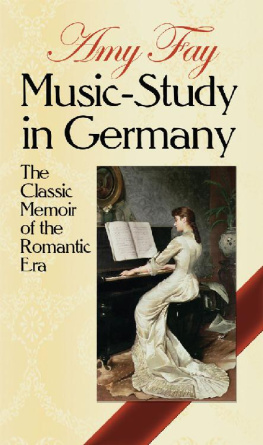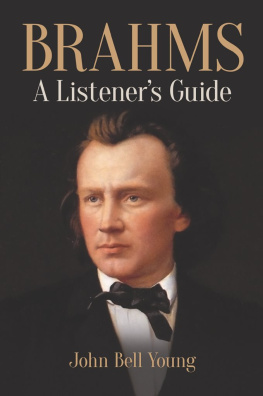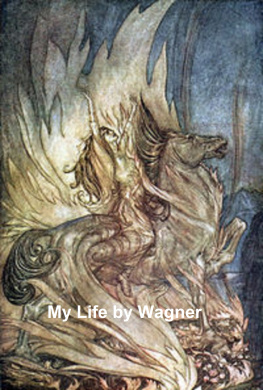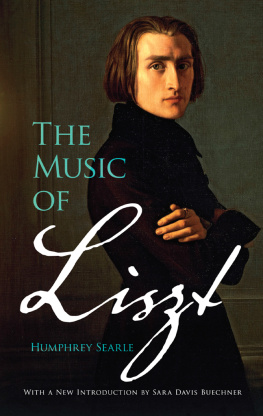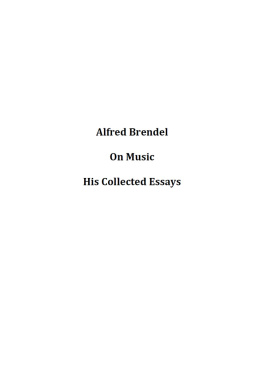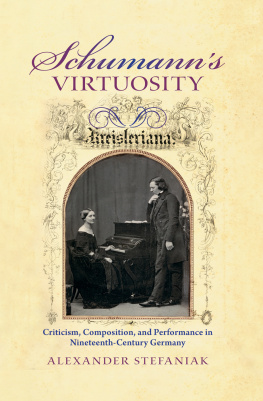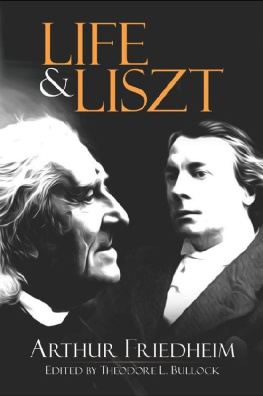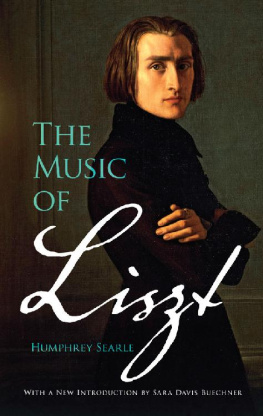MUSIC-STUDY IN GERMANY
The Classic Memoir of the Romantic Era
AMY FAY
W ITH A N EW I NTRODUCTION BY
FRANCES DILLON
M ANNES C OLLEGE OF M USIC
DOVER PUBLICATIONS, INC.
Mineola, New York
Copyright
Copyright 1965, 2011 by Dover Publications, Inc.
All rights reserved.
Bibliographical Note
This Dover edition, first published in 1965 and reprinted in 2011, is an unabridged and corrected republication of the work first published by A.C. McClurg & Company, Chicago, in 1880. The original front matter was replaced by a new introduction written specially for the Dover edition by Frances Dillon.
International Standard Book Number
eISBN-13: 978-0-486-26562-9
Manufactured in the United States by Courier Corporation
26562501
www.doverpublications.com
PREFACE.

In preparing for the public letters which were written only for home, I have hoped that some readers would find in them the charm of style which the writers friends fancy them to possess; that others would think the description of her masters, and especially Liszt, amid their pupils worth preserving; and that piano students would be grateful for the information that such an analysis of the piano technique of the greatest artists has been made, that any earnest pupil can with comparative ease and certainty conquer the difficulty of the piano-forte which includes all othersthe SCALE.
How much of Herr Deppes piano method is original with himself, pianists must decide. That he has at least made an invaluable rsum of all or most of their secrets, my sister believes that no student of the instrument who fairly and conscientiously examines into the matter will deny.
M. F. P.
C HICAGO, Dec, 1880.

The light that never was on sea or land.W ORDSWORTH. Pour admirer assez il faut admirer trop, et un peu dillusion est ncessaire au bonheur.C HERBULIEZ .

Introduction to the Dover Edition
Music-Study in Germany is an important book. It is the result of letters written by Amy Fay during her residence in Germany to her family in America, covering the years from 1869 until 1875. In a casual, lively manner, she describes her student days in vivid detail; her perceptive comments and observations show acute insight into the culture and mores of the places where she lived and the people she met in the principal music cities of Germany.
Born in 1844 in Bayou Goula, a plantation on the banks of the Mississippi, Amy Fay lived there until her fifth birthday. Her father, the Rev. Dr. Charles Fay, a distinguished graduate from Harvard, a scholar and linguist, advocated a thorough classical education for his family. Cognizant of the limited curriculum of the schools in that period when studies remained rudimentary in character, Dr. Fay personally supervised the teaching of languages to his family. Amy, the third of his children, learned to converse, read and write in Latin, Greek, German and French. Her mother, Mrs. Charlotte Fay, daughter of Bishop John Henry Hopkins of the Protestant Episcopal Church of Vermont, was a self-taught pianist. She diligently pursued her study of the more popular piano literature of the Romantic composers. Endowed with an acute ear, a facile technique, and musical discernment, Mrs. Fay broadened her piano repertoire extensively and brought a rich musical environment to her family. Mrs. Fay was guided by the theory that the younger children are when they begin to study, the easier it is to develop their minds. She undertook the tutoring of Amy in music, drawing and expository writing. Successful in initiating a strong musical interest in her children, she considered music to play a dominant role. With gentle guidance and intelligent suggestions, her children were made aware of the cultural and social value of musical participation. Amy Fay, the most talented and the most innately endowed, responded more readily than the other children. Inheriting her mothers aptitude for the piano, Amy, at five, was able to extemporize and perform at a high level of technical and musical proficiency. It became quite obvious that Bayou Goula was hardly capable of providing the proper cultural environment for a family endowed with such intellectual curiosity and artistic needs. Upon request for a transfer, Dr. Fay was granted a parish in St. Albans, Vermont. There, Amy Fays education was continued in academics and piano repertoire, as well as in the socially accepted middle-class New England refinements and artistic accomplishments. The formative period of her life was spent during the turbulent years of the Civil War and the post-bellum adjustment, an era when music creativity as an art form was at a standstill.
Music in America had not yet attained a distinctive voice of its own; it still, and for some time after, reechoed the style and manner of the Europeansand not the representative best. For that, one needed competent and well-disciplined performing organizations: choral societies, orchestras, music educators and music leaders in the community and institutions. These were to come. America was engaged in expanding industrially and economically, and the forces conducive to the full exploitation and expansion of its cultural resources had not yet achieved their full artistic consciousness and intellectual potential. The ubiquitous Yankee was preoccupied with getting rich quick. Young America was undergoing a complete economic transformation. Industry was revolutionized by inventions and the unparalleled natural resources that were available. This was an era of technological growth in which the New World achieved political power and world recognition. The emergence of the arts, on the other hand, suffered neglect during these fitful times.
The music written by our native composers, within their limited capabilities, satisfied the popular demand for tear-filled sentimental ballads. The development of Americas literature outstripped that of Americas music. Novelists, poets and essayists told of its people who toiled courageously on native grounds building a new world. Walt Whitmans robust proclamation reached heights of indigenous creativity when he heard America singing. A self-portrait of genuine validity emerged with the flowering of an American literary heritage. Music, on the other hand, maintained and fanned the dying embers of cheap Romanticism, assimilating the tawdry and the artificial. The authentic American music was its folk-song in which people dramatized the building of the country.
With the rise of the parvenu in the newly risen genteel society it was more expedient to import European performing artists and music teachers than to develop our own. Those artists who were transplanted found and exploited rich musical markets here, influencing composers who molded their artistic endeavors to conform with Central European art. Orchestras were conducted by Europeans and only European music was played. Music flourished and was patronized solely with the label from abroad.
It was William Henry Fry (18151864), an American composer, who published a statement in the Musical World in 1853 in which he publicly denounced the New York Philharmonic Society for not having performed a single composition by a native American during the eleven years of its existence. An indignant reply from the president of the Philharmonic began a lively controversy which revealed that the Societys claim of patronizing American composers in performance actually had been fulfilled twice at public rehearsal. George F. Bristow (18251898), another American composer and performer, joined the controversy through a published letter in which he wrote, As one exception makes a rule stronger, so this single stray fact shows that the Philharmonic Society has been as anti-American as if it had been located in London during the Revolutionary War, and composed of native-born British tories.

